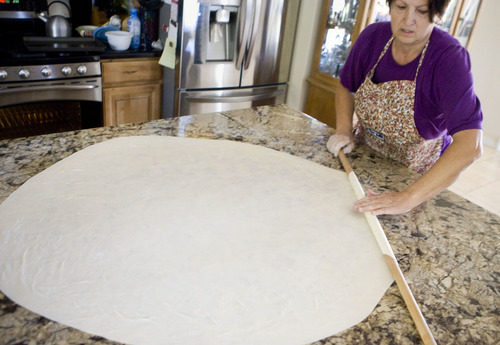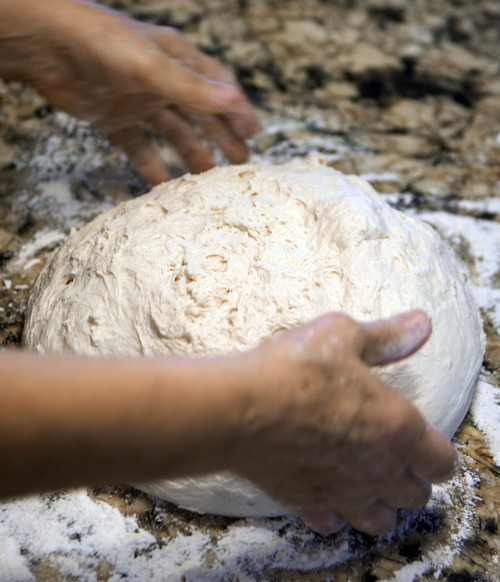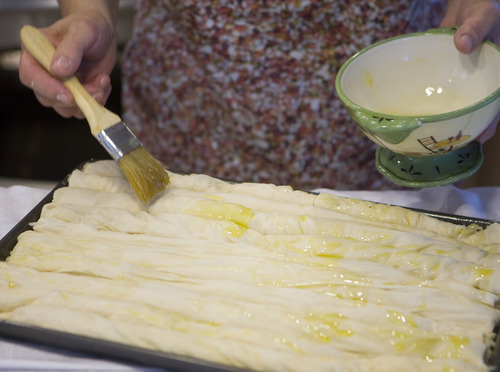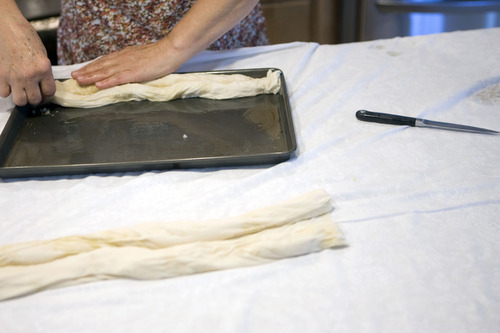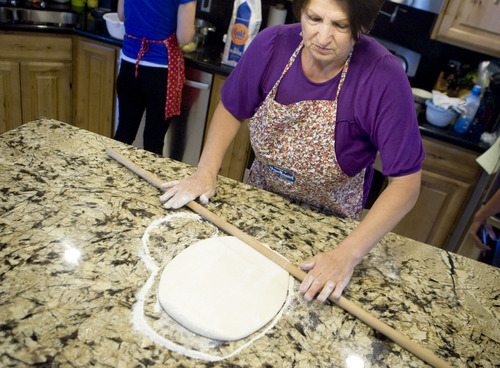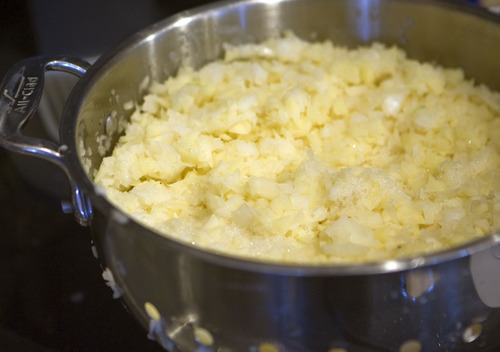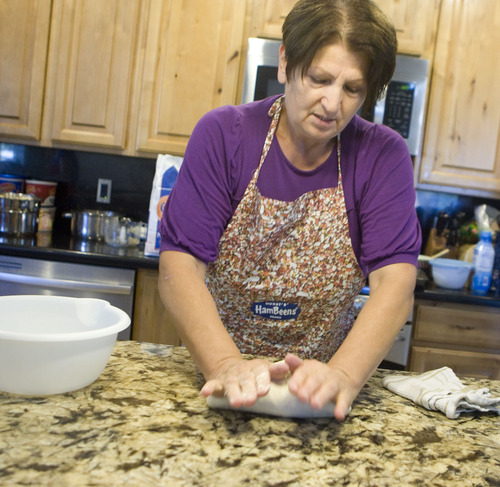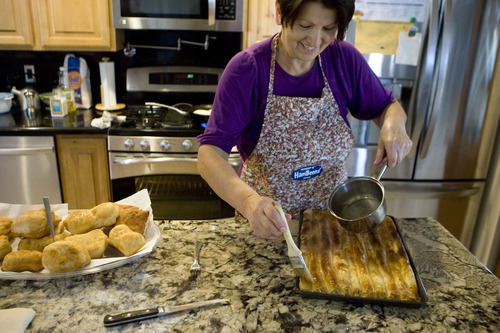This is an archived article that was published on sltrib.com in 2012, and information in the article may be outdated. It is provided only for personal research purposes and may not be reprinted.
When Munira Causevic visits her family in Utah, she usually can be found standing at the kitchen island, rolling out Olympic size-sheets of phyllo dough for Bosnian pitas.
In the three weeks since she arrived, Causevic has made these popular baked pastries filled with meat, cheese and vegetables almost every day, simultaneously satisfying her son Amir Haskic's cravings and filling the freezer of his Sandy home. "One of the ways Amir's mom shows her love is to cook for us," said Haskic's girlfriend Karin Palle.
Causevic said she learned to make pitas as a young girl living in the former Yugoslavia. "When I was little, my mother would cut a small piece of dough for me to practice rolling," she told The Tribune through an interpreter.
Today, her expert skill is quickly becoming a lost art.
In 1992, Causevic and her children left Yugoslavia and moved to Switzerland, just as the civil war and political upheavals started. While they left before the country was divided into Bosnia and other small independent countries, they still feel connected to the region and like to share their culture through food. On Sunday, Oct. 7, Haskic and Palle threw a party that included the Bosnian tradition of roasting a whole lamb on an outdoor spit and a pita-making demonstration by Causevic.
—
As popular as American pizza • Pita is one of Bosnia's most popular foods, second only to the skinless sausages known as cevapi. While typically served as an appetizer, or meze, pitas also make for a quick on-the-go breakfast or lunch, says Sidanija Delic, a native of Bosnia whose family owns Cafe on Main, a Balkan restaurant at 2701 S. Main in Salt Lake City.
Pitas are served both hot and cold, she said, "and are as popular in the Balkan Peninsula as pizza is in America."
Tiny pita shops are located all over Bosnia, with each shop having its own specialty. Many if the fillings are influenced by the surrounding countries of Turkey, Greece, Germany and even Switzerland.
Delic said that pita is actually a generic term for these turnover-like treats. Native Bosnians refer to them by the type of filling inside. Those stuffed with meat are called burek; cheese-and-egg filled pitas are sirnica; while spinach-and-feta cheese pitas are zeljanica. At Haskic's house, Causevic made a potato-and-onion filled krompiracha.
But not all pitas are savory, as many cooks make a sweet strudel with apples and cinnamon called jabukara.
At Cafe on Main, Delic's makes three different kinds of pitas each day — meat, spinach and cheese — all with phyllo that she makes by hand. "They are very popular," she said, adding that sometimes the restaurant runs out before the end of the day.
—
Flour, salt, water and oil • Making the dough is actually the simplest step in the process: All-purpose flour, salt, water and a little bit of oil are combined and kneaded for several minutes to make a soft, pliable dough, which is then left to rest for about 30 minutes.
Things get more complicated when Causevic flours the counter and pulls out her makeshift rolling pin — a long wooden broomstick handle. She starts rolling from the center working outward, the dough getting thinner with each stroke.
After a few moments, Causevic changes her technique, rolling the dough around the pin like a piece of hair around a curler. She massages this curled up dough from the middle toward the edges, stretching it outward as she goes. She unrolls it, moves the pin to another section and repeats the process again and again.
Just when it looks like the dough can't expand any farther without tearing, Causevic drapes it over the rolling pin and lifts it up off the counter. With a bit of assistance, she covers the counter with a white bed sheet and then gently lays the dough on top.
Abandoning the rolling pin, Causevic begins moving around the island, gently pulling at the edges, lengthening the dough until it almost covers the counter and is "thin enough to read a newspaper through," Delic jokes.
Looking a little like a priest blessing food, Causevic sprinkles the dough with oil — and then places her prepared filling around the outer edge. The dough is then rolled up and over the filling to form a long rope.
She cuts the rope into equal-sized strips and places them side-by-side in a rectangular baking pan, where it's brushed with oil and baked — at a high temperature for about 15 minutes; and then medium for another 20 until golden brown.
Hamdija Duzan, Haskic's best friend and fellow Bosnian native, is happy to see this homemade treat come out of the oven. "When people work, they can make this treat every day," he lamented.
Unless your mother comes to visit.
Burek — Bosnian meat pita
Phyllo
4 cups of all-purpose flour, divided
1/2 teaspoon salt
2⁄3 cup (about) very hot water
1 teaspoon white vinegar
1 teaspoon of extra virgin olive oil
Filling
1 tablespoon olive oil
1 medium yellow onion, peeled and chopped
1 pound ground beef
1 teaspoon allspice
2 teaspoons Hungarian paprika
Salt and freshly ground black pepper
3/4 cup olive oil
For the phyllo, place 3 cups of flour in a large bowl (the remaining cup will be used when rolling out the dough). Make a well in the center and add 1/2 cup water and the vinegar. Combine with a fork. Add olive oil and continue mixing, adding more water if needed to make a soft dough. Turn the dough out onto a floured surface and knead by hand, oiling hands if needed, until the dough is soft, malleable, and smooth, 10-15 minutes. Cover with plastic wrap and let the dough rest for 30 minutes.
Meanwhile, make the filling. Heat a large frying pan and add the oil. Saute the onion until soft, and then add the ground beef, allspice, paprika, salt, and pepper to taste. Cook until the meat is crumbly but not dry. Cool completely.
Heat oven to 450 degrees.
Remove the rested dough to a lightly floured work surface and roll out into a large rectangle. Place floured fists underneath the dough and gently pull sections of the dough out until it is very thin. Take care not to tear holes in the dough. If you do, pinch them together. Let the dough rest for 10 minutes or so to dry out a little.
Brush the pastry dough all over with melted butter or olive oil. Place a row of the meat filling along the longer edge of the rolled out pastry dough, leaving a 1-inch border. Bring the bottom of the pastry up over the meat filling and roll it up into a long sausage-shaped roll.
Grease a rectangular shaped baking pan. Cut into equal-sized strips and placed side-by-side in prepared baking pan.
(For a spiral shaped pita, grease a large round baking pan. Lay one end of the roll in the middle of the prepared pan. Carefully wrap the remainder of the pastry roll around itself to form a snail-shaped pie in the middle of the baking pan.)
Brush the top of the pastry with melted butter or olive oil. Place in the oven and bake for 10 minutes. Reduce heat to 350 degrees and continue to cook for another 20 to 30 minutes, or until cooked through and golden-brown. Remove from oven and cool slightly. Cut into pieces and serve. Good warm or cold.
Servings • 8-10 as appetizer.
Source: Adapted from The Great Family Cookbook Project and about.com


